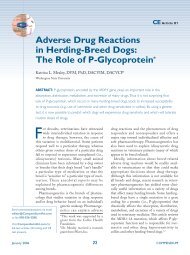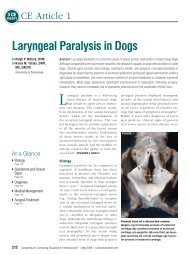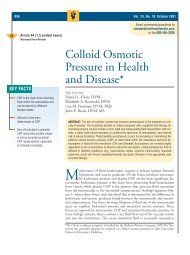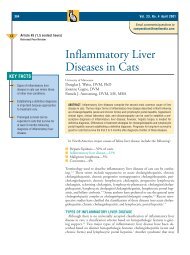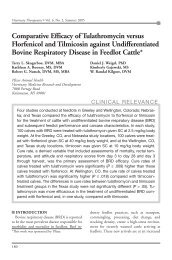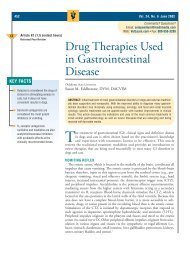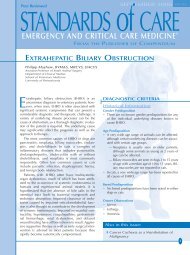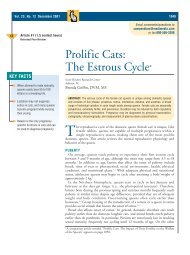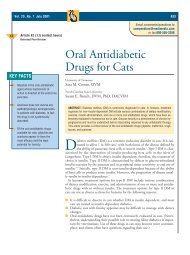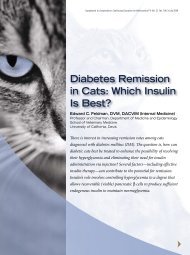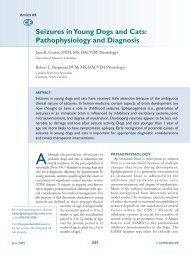cearticle #4 ce test - VetLearn.com
cearticle #4 ce test - VetLearn.com
cearticle #4 ce test - VetLearn.com
You also want an ePaper? Increase the reach of your titles
YUMPU automatically turns print PDFs into web optimized ePapers that Google loves.
CE<br />
854 Vol. 25, No. 11 November 2003<br />
Article <strong>#4</strong> (1.5 contact hours)<br />
Refereed Peer Review<br />
KEY FACTS<br />
■ Clinical signs of upper airway<br />
obstruction should raise a<br />
clinician’s suspicion for tracheal<br />
neoplasia as a diagnostic<br />
differential.<br />
■ Caution during diagnostics and<br />
therapeutics is needed to<br />
prevent respiratory<br />
embarrassment.<br />
■ Treatment for tracheal tumors<br />
may include surgical removal,<br />
chemotherapy, and/or radiation<br />
therapy, depending on tumor<br />
type and stage.<br />
V<br />
Comments? Questions?<br />
Email: <strong>com</strong>pendium@medimedia.<strong>com</strong><br />
Web: <strong>VetLearn</strong>.<strong>com</strong> • Fax: 800-556-3288<br />
Primary Tracheal Tumors<br />
in Dogs and Cats<br />
Texas A&M University<br />
M. Raquel Brown, DVM, DACVIM (Internal Medicine)<br />
Kenita S. Rogers, DVM, MS, DACVIM (Internal Medicine, Oncology)<br />
ABSTRACT: Primary neoplasms of the trachea are un<strong>com</strong>mon in dogs and cats. Patients are<br />
often middle aged or older, ex<strong>ce</strong>pt dogs with osteochondromas. Clinical signs consistent with<br />
tracheal obstruction, including dyspnea, wheezing, stridor, and cough, are <strong>com</strong>mon. Caution<br />
should be used during diagnostics and therapeutics to prevent respiratory embarrassment.<br />
Survey radiography often reveals the mass, and bronchoscopy allows direct visualization and<br />
sampling of the lesion. Options for treatment include surgical excision, chemotherapy, radiation<br />
therapy, or some <strong>com</strong>bination of these methods. Most tumors respond well to <strong>com</strong>plete surgical<br />
excision, although lymphoma responds best to chemotherapy, with or without adjunctive<br />
radiation therapy. Data on long-term follow-up are not available, but prognosis most likely<br />
depends on tumor type and stage.<br />
Primary neoplasms of the trachea are un<strong>com</strong>mon in animals and humans,<br />
and both benign and malignant tumor types occur. 1–5 Most patients are<br />
older, although young dogs with active osteochondral ossification sites are<br />
at a higher risk of benign tracheal osteochondromas. 5,6 Clinical signs of upper<br />
airway obstruction, including dyspnea, stridor, wheezing, exercise intoleran<strong>ce</strong>,<br />
and cough, should raise the clinician’s suspicion of this problem, and radiography<br />
often supports the diagnosis. 2 Treatment options include surgical removal,<br />
chemotherapy, radiation therapy, and various <strong>com</strong>binations of these modalities.<br />
Treatment re<strong>com</strong>mendations depend on tumor type and staging. Prognosis for<br />
these patients must be considered guarded because long-term follow-up of large<br />
case series has not been reported. Prognosis most likely depends on tumor type. 2<br />
SIGNALMENT<br />
Canine primary tracheal tumors often present in a bimodal age distribution<br />
1,2,6–16 (Table 1). Of the reported ages in the literature, eight dogs were 2<br />
years of age and younger, and 10 were 6 years of age and older, with osteochondroma<br />
and ecchondroma/osteochondromal dysplasia occurring in younger<br />
dogs. 13–16 Both males and females are affected, with various breeds represented<br />
(Table 1).<br />
Cats are often older, with the mean age of reported cases being 9.5 years 1,7–27<br />
(Table 2). Both sexes are represented, with domestic short-haired and Siamese<br />
most <strong>com</strong>monly affected. Of the 19 reported cases of feline tracheal tumors,<br />
feline leukemia virus (FeLV) status was reported in seven cats, and one had<br />
www.<strong>VetLearn</strong>.<strong>com</strong>
Compendium November 2003 Primary Tracheal Tumors in Dogs and Cats 855<br />
Table 1. Reported Primary Tracheal Tumors in Dogs<br />
Age<br />
Study (years) Sex Breed Sign(s) Tumor Type Treatment Out<strong>com</strong>e<br />
Carlisle et al1 12 FS Miniature Cough Adenocarcinoma None Euthanized<br />
poodle Sneeze<br />
Hill et al7 10 M Spitz Dyspnea Carcinoma — —<br />
Harvey and 8 M Siberian Dyspnea Mast <strong>ce</strong>ll tumor Surgery —<br />
Sykes11 husky<br />
Carlisle et al1 13 F German Dyspnea Mast <strong>ce</strong>ll tumor None Euthanized<br />
shepherd Stridor<br />
Bryan et al10 “Aged” F Mix Dyspnea Leiomyoma Surgery Alive after<br />
6 months<br />
Black et al9 10 M Miniature Panting Leiomyoma Surgery Alive after<br />
poodle 7 months<br />
Chaffin et al2 10 FS Mix Dyspnea Extramedullary Surgery Alive after<br />
plasmacytoma 3 months<br />
Brodey et al12 7 F Mix Cough Osteosar<strong>com</strong>a None Euthanized<br />
Carlisle et al1 10 F Collie Dyspnea<br />
Stridor<br />
Chondroma Surgery —<br />
Aron et al8 6 M German Dyspnea Chondrosar<strong>com</strong>a Surgery Alive after<br />
shepherd Cough<br />
Voi<strong>ce</strong> change<br />
12 months<br />
Carlisle et al1 1 FS Doberman Dyspnea Chondrosar<strong>com</strong>a Surgery Alive, but<br />
Stridor metastasis<br />
after 9<br />
months<br />
Hough et al15 0.5 F Labrador Dyspnea Osteochondroma Surgery Alive after<br />
retriever 6 months<br />
Withrow et al6 0.25 M Old Wheeze Osteochondroma Surgery Alive after<br />
English<br />
sheepdog<br />
7 months<br />
Dubielzig and 0.5 — Alaskan Dyspnea Osteochondroma None Died during<br />
Dickey14 malamute diagnostics<br />
Gourley et al16 0.9 F Alaskan Collapse Osteochondroma Surgery Alive after<br />
malamute 8 months<br />
Carlisle et al1 0.5 M German Wheeze Osteochondroma Surgery —<br />
shepherd Cyanosis<br />
Carb and 0.9 M Siberian Dyspnea Ecchondroma Surgery Alive after<br />
Halliwell13 husky (osteochondral<br />
dysplasia)<br />
5 months<br />
Carb and 2 F Mix Dyspnea Ecchondroma Surgery Alive after<br />
Halliwell13 (osteochondral<br />
dysplasia)<br />
1 year<br />
FS = female spayed; dashes indicate unknown data.<br />
www.<strong>VetLearn</strong>.<strong>com</strong>
856 Small Animal/Exotics Compendium November 2003<br />
Table 2. Reported Primary Tracheal Tumors in Cats<br />
Age FeLV/FIV<br />
Study (years) Sex Breed Status Sign(s) Tumor Type Treatment Out<strong>com</strong>e<br />
Brown and 10 FS DLH — Cough Lymphoma Medical Euthanized<br />
Rogers25 Wheeze after 38 days<br />
Brown and 11 CM DSH FeLV–, FIV– Dyspnea Lymphoma Medical Alive after<br />
Rogers25 Radiation 21 months<br />
Brown and 4 CM DSH FeLV–, FIV– Cough Lymphoma Medical Alive after<br />
Rogers25 Wheeze 23 months<br />
Brown and 13 CM DSH FeLV–, FIV– Wheeze Lymphoma Medical Alive after<br />
Rogers25 Cyanosis Radiation 17 months<br />
Schnieder 7 M Siamese FeLV+ Dyspnea Lymphoma Medical Alive after<br />
et al23 Surgical 8 months<br />
Zimmerman 9 M Siamese — Dyspnea Lymphoma Surgical Recurred<br />
et al22 Euthanized<br />
after 10 days<br />
Beaumont17 11 CM DSH FeLV–, FIV– Dyspnea Lymphoma Surgical Systemic after<br />
4 months<br />
Kim et al24 13 FS Siamese FeLV–, FIV– Dyspnea Lymphoma None Euthanized<br />
Beaumont17 11 FS Siamese — Dyspnea Adenocarcinoma None Euthanized<br />
Cain and<br />
Manley<br />
10 — Siamese — Cough Adenocarcinoma Surgical —<br />
19<br />
Evers et al20 12 CM DSH FeLV– Dyspnea Adenocarcinoma Surgical Recurred<br />
Euthanized<br />
after 12<br />
months<br />
Zimmerman 12 M Persian — Dyspnea Adenocarcinoma Surgical Alive after<br />
et al22 Cough 12 months<br />
Evers et al20 12 FS DSH — Dyspnea Adenocarcinoma Surgical Alive after<br />
3 months<br />
Neer and 7 — DLH — Wheeze Adenocarcinoma Surgical Recurred<br />
Zeman18 Dyspnea Euthanized<br />
after 17<br />
months<br />
Carlisle et al1 6 FS Domestic — Stridor Seromucinous<br />
carcinoma<br />
None Euthanized<br />
Glock21 6 — — — Weight<br />
loss<br />
Adenoma None Euthanized<br />
Lobetti and 11 CM DSH — Dyspnea Squamous <strong>ce</strong>ll None Euthanized<br />
Williams26 carcinoma<br />
Carlisle et al1 9 M Domestic — Wheeze Carcinoma Surgical Died after<br />
Dyspnea 15 months<br />
Veith27 2 CM DSH — Dyspnea Squamous <strong>ce</strong>ll<br />
carcinoma<br />
None Died<br />
CM = castrated male; DLH = domestic long-haired; DSH = domestic short-haired; FS = female spayed; dashes indicate unknown data.<br />
www.<strong>VetLearn</strong>.<strong>com</strong>
Compendium November 2003 Primary Tracheal Tumors in Dogs and Cats 857<br />
Figure 1—Thoracic radiograph of a cat with intratracheal lymphoma. Note the<br />
multiple masses within the tracheal lumen (arrows). (From Brown MR, Rogers<br />
KS, Mansell KJ, et al: Primary intratracheal lymphosar<strong>com</strong>a in four cats.<br />
JAAHA 39:468–472, 2003; with permission)<br />
positive results on an immunofluores<strong>ce</strong>nt antibody <strong>test</strong>.<br />
Of the five cats <strong>test</strong>ed for feline immunodeficiency<br />
virus (FIV), all had negative results.<br />
HISTORY AND CLINICAL SIGNS<br />
Acute, intermittent, or chronic and progressive signs<br />
of tracheal obstruction may prompt presentation<br />
of the patient to the veterinarian. 28 Dyspnea, wheezing,<br />
exercise intoleran<strong>ce</strong>, and coughing are <strong>com</strong>mon <strong>com</strong>plaints.<br />
2,29 Depression, voi<strong>ce</strong> change, intermittent<br />
cyanosis, inability to bark, collapse, or weight loss may<br />
also be noted. 8,16,21 Although some patients present with<br />
no overt clinical signs, many are in obvious respiratory<br />
distress. Along with the clinical signs already listed,<br />
referred upper airway sounds may be auscultated. 29<br />
Patients may be<strong>com</strong>e cyanotic with the stress of physical<br />
examination. Cats may begin open-mouth breathing<br />
or may present in a crouched stan<strong>ce</strong> with their head<br />
and neck extended. 4 Patients may show a preferen<strong>ce</strong> for<br />
sternal recumbency over lateral recumbency. 4 A 6month-old<br />
Alaskan malamute that presented for osteochondroma<br />
of the trachea had obvious hemorrhage at<br />
the laryngeal opening. 14<br />
DIAGNOSTICS<br />
When the patient’s condition permits, radiography is<br />
the diagnostic pro<strong>ce</strong>dure of choi<strong>ce</strong>. 30 Tracheal tumors are<br />
often dis<strong>ce</strong>rnible on survey radiography because these<br />
masses are outlined by tracheal air, which provides a natural<br />
contrast medium 29 (Figure 1). If tracheal neoplasia is<br />
considered a diagnostic differential and the thoracic radiographs<br />
are within normal limits, radiographs of the<br />
neck should be obtained. Intratracheal masses may present<br />
in a variety of locations within the trachea, from just<br />
www.<strong>VetLearn</strong>.<strong>com</strong><br />
caudal to the larynx to the carina. Overexpansion<br />
of the lungs, flattening of the diaphragm,<br />
and prominent pulmonary vasculature<br />
secondary to increased air content of<br />
the lungs have been noted in cats with<br />
intratracheal tumors. 25 If severe respiratory<br />
embarrassment is present, oxygen therapy<br />
or sedation may be ne<strong>ce</strong>ssary to obtain<br />
diagnostic radiographs without endangering<br />
the patient. 4<br />
Bronchoscopy offers direct visualization<br />
of the mass(es) (Figure 2), unless substantial<br />
hemorrhaging is present. Brush<br />
cytology and biopsies may also be<br />
obtained for evaluation 30 (Figure 3). Brush<br />
cytology offers the clinician the potential<br />
to make an immediate diagnosis and provide<br />
immediate treatment.<br />
DIFFERENTIAL DIAGNOSIS<br />
Intratracheal mast <strong>ce</strong>ll tumor, 1,11 adenocarcinoma, 1<br />
carcinoma, 7 leiomyoma, 9,10 chondroma, 10 osteosar<strong>com</strong>a,<br />
12 extramedullary plasmacytoma, 2 rhabdomyosar<strong>com</strong>a,<br />
and chondrosar<strong>com</strong>a 1,8 have been reported in<br />
dogs. Five cases of osteochondroma 1,6,14–16 and two cases<br />
of ecchondroma/osteochondromal dysplasia 13 have<br />
been reported in young dogs. These benign tracheal<br />
osteocartilaginous tumors grow in synchrony with the<br />
rest of the musculoskeletal system and, therefore,<br />
should stop growing with skeletal maturity. Intraluminal<br />
adenocarcinoma, 17–22 lymphoma, 17,22–25 squamous<br />
<strong>ce</strong>ll carcinoma, 26,27 and adenoma 21 have been reported<br />
in cats. Intratracheal neoplasms must be differentiated<br />
from nonneoplastic intraluminal masses. Differentials<br />
for nonneoplastic intraluminal masses include polyps, 31<br />
eosinophilic granulomas, 32 nodular amyloidosis, 33 tissue<br />
reaction to Filaroides osleri, 34 chondromatous hamartoma,<br />
35 papillomatosis, 36 and hyperplastic tracheitis of<br />
unknown cause. 37 Stenosis of the tracheal lumen may<br />
be iatrogenically indu<strong>ce</strong>d via ex<strong>ce</strong>ssive inflation of an<br />
endotracheal tube or other trauma. 38,39<br />
STAGING<br />
Ideally, all dogs and cats with neoplasia should<br />
undergo staging before definitive treatment re<strong>com</strong>mendations<br />
are made. 30 Intratracheal neoplasms causing respiratory<br />
<strong>com</strong>promise sometimes present an ex<strong>ce</strong>ption<br />
to this rule because immediate therapy may need to be<br />
initiated. If time permits, clinical pathology and imaging<br />
modalities should be performed. For all animals, a<br />
<strong>com</strong>plete blood <strong>ce</strong>ll count, chemistry profile, and urinalysis<br />
should be conducted. 30 FeLV and FIV status<br />
should be determined in all cats. Thoracic radiographs
858 Small Animal/Exotics Compendium November 2003<br />
Figure 2—Photograph taken during bronchoscopy of a dog<br />
with an intratracheal tumor.<br />
should be evaluated for eviden<strong>ce</strong> of metastasis. Abdominal<br />
ultrasonography allows evaluation of systemic disease,<br />
including systemic neoplasia, when abdominal<br />
palpation may not fully define abdominal disease. Cats<br />
with heart murmurs should undergo echocardiography<br />
before anesthesia, if possible. This not only allows a<br />
proper anesthetic induction, protocol to be chosen but<br />
also potentially identifies any underlying or <strong>com</strong>plicating<br />
disease pro<strong>ce</strong>sses. The acquired information can<br />
also guide treatment choi<strong>ce</strong>s (e.g., Is the animal a good<br />
candidate for chemotherapy?).<br />
TREATMENT<br />
Treatment options include surgical removal,<br />
chemotherapy, radiation therapy, or a <strong>com</strong>bination of<br />
these modalities, depending on tumor type and stage. 2<br />
Surgical removal is the only reported treatment attempted<br />
in dogs, either by resection of the trachea 1,2,8,10,11,15,16 or<br />
endoscopic removal by snaring. 6 Surgery is the treatment<br />
of choi<strong>ce</strong> for solitary tracheal tumors without eviden<strong>ce</strong> of<br />
metastatic disease. 30 Surgical therapy may provide shortterm<br />
palliative relief of airway obstruction for tracheal<br />
tumors exhibiting local and metastatic spread. Although<br />
out<strong>com</strong>e was not reported for one dog with a mast <strong>ce</strong>ll<br />
tumor, 11 follow-up times were reported for most dogs<br />
with osteochondroma (6, 7, and 8 months), 6,15,16 leiomyoma<br />
(6 and 7 months), 9,10 ecchondroma/osteochondromal<br />
dysplasia (5 and 12 months), 13 extramedullary plasmacytoma<br />
(3 months), 2 and chondrosar<strong>com</strong>a (9 and 12<br />
months). 8 Therefore, short-term survival with surgical<br />
www.<strong>VetLearn</strong>.<strong>com</strong><br />
Figure 3—Histopathology from a cat with an intratracheal<br />
mass diagnosed as lymphoma. (From Brown MR, Rogers KS,<br />
Mansell KJ, et al: Primary intratracheal lymphosar<strong>com</strong>a in<br />
four cats. JAAHA 39:468–472, 2003; with permission)<br />
resection appears adequate, but long-term prognosis cannot<br />
be fully evaluated.<br />
Cats with intratracheal adenocarcinoma have been<br />
followed for up to 17 months. Two cats that had surgical<br />
resection were clinically well at 3 and 12 months. 20,22<br />
One cat had an adenocarcinoma suctioned during<br />
bronchoscopy twi<strong>ce</strong>, affording the cat an additional 17<br />
months of life. 18 Intratracheal lymphoma has not<br />
responded well to surgical removal alone. One cat had<br />
recurren<strong>ce</strong> of disease within 10 days, 22 and another had<br />
systemic lymphoma at 4 months postoperatively. 17<br />
The main indication for radiation and chemotherapy<br />
is for intratracheal tumors of lymphoid origin. This<br />
extranodal lymphoma is quite sensitive to radiation<br />
therapy and should be considered immediately after the<br />
cytologic or histologic diagnosis has been made. Radiation<br />
provides a rapid reduction of tumor burden, allowing<br />
a more immediate improvement in the patient’s respiratory<br />
status. Chemotherapy can also delay local or<br />
systemic recurren<strong>ce</strong> of lymphoma. Two cats were tumor<br />
free for 17 and 21 months after a <strong>com</strong>bination of<br />
chemotherapy and radiation was used to treat intratracheal<br />
lymphoma. 25<br />
PROGNOSIS<br />
Prognosis depends on tumor type, stage of disease,<br />
and underlying disease. Osteochondromas of young<br />
dogs appear to carry the best prognosis. Other canine<br />
and feline tracheal tumors have not been followed longterm<br />
after surgical resection, but patients appear to<br />
respond well to surgery, reportedly with survival times<br />
of several months. Cats with tracheal lymphoma may<br />
do well after radiation, systemic chemotherapy, or a<br />
<strong>com</strong>bination of these two modalities.
Compendium November 2003 Primary Tracheal Tumors in Dogs and Cats 859<br />
CONCLUSION<br />
Primary intratracheal neoplasia is un<strong>com</strong>mon in dogs<br />
and cats, with only 37 cases reported in the veterinary<br />
literature. Clinical signs are associated with airway<br />
obstruction, including dyspnea, wheezing, and exercise<br />
intoleran<strong>ce</strong>. Radiography often reveals a soft tissue density<br />
within the tracheal lumen. Bronchoscopy allows<br />
direct visualization and sampling for cytology and<br />
histopathology. Treatment re<strong>com</strong>mendations may<br />
include surgical removal, chemotherapy, radiation therapy,<br />
or a <strong>com</strong>bination of these methods, depending on<br />
the tumor type and stage. Until long-term follow-up is<br />
observed and reported, the prognosis for these patients<br />
must be considered guarded. Prognosis most likely<br />
depends on tumor type.<br />
REFERENCES<br />
1. Carlisle CH, Biery DN, Thrall DE: Tracheal and laryngeal<br />
tumors in the dog and cat: Literature review and 13 additional<br />
patients. Vet Radiol 32(5):229–235, 1991.<br />
2. Chaffin K, Cross AR, Allen SW, et al: Extramedullary plasmacytoma<br />
in the trachea of a dog. JAVMA 212(10):1579–1581,<br />
1998.<br />
3. Ogilvie GK, Moore AS: Tumors of the respiratory tract, in<br />
Feline Oncology. Yardley, PA, Veterinary Learning Systems, 2001,<br />
pp 368–384.<br />
4. Stann SE, Bauer TG: Respiratory tract tumors. Vet Clin North<br />
Am Small Anim Pract 15:535–556, 1985.<br />
5. Withrow SJ: Tumors of the respiratory system, in Clinical Veterinary<br />
Oncology. Philadelphia, Lippincott, 1989, pp 215–233.<br />
6. Withrow SJ, Holmberg DL, Rosychuk RA, et al: Treatment of a<br />
tracheal osteochondroma with an overlapping end-to-end tracheal<br />
anastomosis. JAAHA 14(4):469–473, 1978.<br />
7. Hill JE, Mahaffey EA, Farrell RL: Tracheal carcinoma in a dog.<br />
J Comp Pathol 97:705–707, 1987.<br />
8. Aron DN, DeVries R, Short CE: Primary tracheal chondrosar<strong>com</strong>a<br />
in a dog: A case report with description of surgical and<br />
anesthetic techniques. JAAHA 16:31–37, 1980.<br />
9. Black AP, Liu S, Randolph JF: Primary tracheal leiomyoma in a<br />
dog. JAVMA 179:179, 905–907, 1981.<br />
10. Bryan RD, Frame RW, Kier AB: Tracheal leiomyoma in a dog.<br />
JAVMA 178:1069–1070, 1981.<br />
11. Harvey HJ, Sykes G: Tracheal mast <strong>ce</strong>ll tumor in a dog. JAVMA<br />
180:1097–1100, 1982.<br />
12. Brodey RS, O’Brien J, Berg P, et al: Osteosar<strong>com</strong>a of the upper<br />
airway in the dog. JAVMA 155:1460–1464, 1969.<br />
13. Carb A, Halliwell WH: Osteochondral dysplasias of the canine<br />
trachea. JAAHA 17:193–199, 1981.<br />
14. Dubielzig RR, Dickey DL: Tracheal osetochondroma in a young<br />
dog. Vet Med Small Anim Clin 73:1288–1290, 1978.<br />
15. Hough JD, Krahwinkel DJ, Evans AT, et al: Tracheal osteochondroma<br />
in a dog. JAVMA 170(12):1416–1418, 1977.<br />
16. Gourley IG, Morgan JP, Gould DH: Tracheal osteochondroma<br />
in a dog: A case report. J Small Anim Pract 11:327–335, 1970.<br />
www.<strong>VetLearn</strong>.<strong>com</strong><br />
17. Beaumont PR: Intratracheal neoplasia in two cats. J Small Anim<br />
Pract 23:29–35, 1982.<br />
18. Neer TM, Zeman D: Tracheal adenocarcinoma in a cat and<br />
review of the literature. JAAHA 23(4):377–380, 1987.<br />
19. Cain GR, Manley P: Tracheal adenocarcinoma in a cat. JAVMA<br />
182(6):614–616, 1983.<br />
20. Evers P, Sukhiani HR, Sumner-Smith G, et al: Tracheal adenocarcinoma<br />
in two domestic shorthaired cats. J Small Anim Pract<br />
35:217–220, 1994.<br />
21. Glock R: Primary pulmonary adenomas of the feline. Iowa State<br />
University Veterinarian 23:155–156, 1961.<br />
22. Zimmerman U, Muller F, Pfleghaar S: Zwei falle von histogenetisch<br />
unterschiedlichen trachealtmoren bei katzen. Kleintierpraxis<br />
37:409–442, 1992.<br />
23. Schnieder PR, Smith CW, Feller DL: Histiocytic lymphosar<strong>com</strong>a<br />
of the trachea in a cat. JAAHA 15:485–487, 1979.<br />
24. Kim DY, Kim JR, Taylor W, et al: Primary extranodal lymphosar<strong>com</strong>a<br />
of the trachea in a cat. J Vet Med Sci 58(7):703–<br />
706, 1996.<br />
25. Brown MR, Rogers KS: Primary intratracheal lymphoma in four<br />
cats. JAAHA, in press.<br />
26. Lobetti RG, Williams MC: Anaplastic tracheal squamous <strong>ce</strong>ll<br />
carcinoma in a cat. J South Afr Vet Assoc 63:132–133, 1992.<br />
27. Veith LA: Squamous <strong>ce</strong>ll carcinoma of the trachea in a cat.<br />
Feline Pract 4(1):30–32, 1974.<br />
28. Norris AM, Henderson RA, Withrow SJ: Respiratory system, in<br />
Textbook of Small Animal Surgery. Philadelphia, WB Saunders,<br />
1985, pp 2583–2592.<br />
29. Ettinger SJ, Ti<strong>ce</strong>r JW: Diseases of the trachea, in Textbook of Veterinary<br />
Internal Medicine, ed 3. Philadelphia, WB Saunders,<br />
1989, pp 795–815.<br />
30. Bell FW: Neoplastic diseases of the thorax. Vet Clin North Am<br />
Small Anim Pract 17:387–409, 1987.<br />
31. Sheaffer KA, Dillon AR: Obstructive tracheal mass due to an<br />
inflammatory polyp in a cat. JAAHA 32:431–434, 1996.<br />
32. Brovida C, Castagnaro M: Tracheal obstruction due to an<br />
eosinophilic granuloma in a dog: Surgical treatment and clinicopathological<br />
observations. JAAHA 28:8–12, 1992.<br />
33. Dill GS, Stookey JL, Whitney GD: Nodular amyloidosis in the<br />
trachea of a dog. Vet Pathol 9:238–242, 1972.<br />
34. Burrows CF, O’Briend JA, Biery DN: Pneumothorax due to<br />
Filaroides osleri infestation in the dog. J Small Anim Pract 3:613–<br />
618, 1972.<br />
35. Pearson GR, Lane JG, Holt PE, et al: Chondromatous hamartomas<br />
of the respiratory tract in the dog. J Small Anim Pract 28:<br />
705–712, 1987.<br />
36. Kelly DF: Papillomatosis of the trachea and bronchi in a dog. J<br />
Pathol 88:590–591, 1964.<br />
37. DeRick A, VanBree H, Hoorens J, et al: Tracheal obstruction<br />
due to a nodular hyperplastic tracheitis in a dog. J Small Anim<br />
Pract 18:473–477, 1977.<br />
38. Knecht CD, Schall WD, Barrett R: Iatrogenic tracheostenosis in<br />
a dog. JAVMA 160(10):1427–1429, 1972.<br />
39. Gordon W: Surgical correction of tracheal stenosis in a dog.<br />
JAVMA 162(6):479–480, 1973.
860 Small Animal/Exotics Compendium November 2003<br />
ARTICLE<br />
CE<br />
<strong>#4</strong> CE TEST<br />
The article you have read qualifies for 1.5 contact<br />
hours of Continuing Education Credit from<br />
the Auburn University College of Veterinary Med-<br />
icine. Choose the best answer to each of the follow-<br />
ing questions; then mark your answers on the<br />
postage-paid envelope inserted in Compendium.<br />
1. Because canine tracheal neoplasms present in a bimodal<br />
age distribution, dogs 2 years of age or younger are<br />
most likely to present with<br />
a. mast <strong>ce</strong>ll tumor. c. chondrosar<strong>com</strong>a.<br />
b. leiomyoma. d. osteochondroma.<br />
2. Which of the following are reported clinical signs for<br />
patients with tracheal tumors?<br />
a. wheezing and dyspnea<br />
b. cough and exercise intoleran<strong>ce</strong><br />
c. voi<strong>ce</strong> change or inability to bark<br />
d. all of the above<br />
3. Which of the following is the diagnostic pro<strong>ce</strong>dure of<br />
choi<strong>ce</strong> for confirming suspicions of an intratracheal<br />
mass?<br />
a. contrast radiography c. bronchoscopy<br />
b. survey radiography d. exploratory surgery<br />
4. Which of the following parasites may cause intratracheal<br />
nodules as a result of tissue reaction against the<br />
parasite?<br />
a. Oslerus hirthi<br />
b. Aelurostrongylus abstrusus<br />
c. Filaroides osleri<br />
d. Paragonimus kellicotti<br />
5. An unstable, dyspneic cat has been anesthetized, and<br />
bronchoscopy has revealed a mass. Cytology of the<br />
mass reveals lymphoma. Before the cat recovers from<br />
anesthesia, the therapy that would offer the quickest<br />
reduction of the tumor burden would be<br />
a. chemotherapy.<br />
b. radiation therapy.<br />
www.<strong>VetLearn</strong>.<strong>com</strong><br />
c. surgical excision.<br />
d. medical management with prednisone.<br />
6. Surgical resection is the treatment of choi<strong>ce</strong> for all of<br />
the following ex<strong>ce</strong>pt<br />
a. lymphoma.<br />
b. adenocarcinoma.<br />
c. osteochondroma.<br />
d. leiomyoma.<br />
7. Which of the following is considered a benign osteocartilaginous<br />
tumor that grows in synchrony with the<br />
rest of the musculoskeletal system and should stop<br />
growing at skeletal maturity?<br />
a. leiomyoma<br />
b. chondroma<br />
c. osteochondroma<br />
d. osteosar<strong>com</strong>a<br />
8. When a patient presents with clinical signs consistent<br />
with a tracheal tumor, the first priority should be to<br />
a. obtain plain radiographs to identify the problem.<br />
b. stabilize the patient with oxygen and other supportive<br />
measures.<br />
c. perform bronchoscopy to obtain a sample for cytology<br />
and histopathology.<br />
d. submit blood for a <strong>com</strong>plete blood <strong>ce</strong>ll count and<br />
chemistry profile.<br />
9. All of the following have been noted in cats with intratracheal<br />
tumors ex<strong>ce</strong>pt<br />
a. overexpansion of the lungs.<br />
b. flattening of the diaphragm.<br />
c. underexpansion of the lungs.<br />
d. prominent pulmonary vasculature.<br />
10. Which of the following statements regarding FIV and<br />
FeLV is true?<br />
a. FIV is <strong>com</strong>mon in cats with tracheal neoplasia.<br />
b. FIV and FeLV are <strong>com</strong>mon in cats with tracheal<br />
neoplasia.<br />
c. FIV <strong>test</strong>ing was reported in four of 19 cats, and all<br />
cats were negative for the virus.<br />
d. All cats with tracheal neoplasia are FeLV positive.



